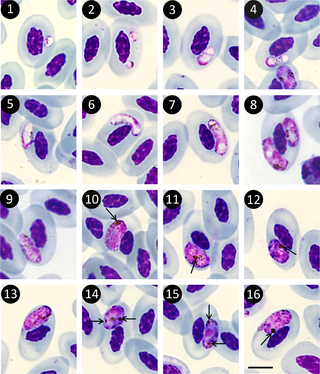
The Plasmodiidae are a family of apicomplexan parasites, including the type genus Plasmodium, which is responsible for malaria. This family was erected in 1903 by Mesnil and is one of the four families in the order Haemospororida.
Plasmodium kentropyxi is a parasite of the genus Plasmodium subgenus Sauramoeba.

Leucocytozoon is a genus of parasitic alveolates belonging to the phylum Apicomplexa.

The spectacled caiman, also known as the white caiman, common caiman, and speckled caiman, is a crocodilian in the family Alligatoridae. It is brownish-, greenish-, or yellowish-gray colored and has a spectacle-like ridge between its eyes, which is where its common name come from. It grows to a length of 1.4–2.5 m and a weight of 7–40 kg (15–88 lb), with males being both longer and heavier than females. Its diet varies seasonally, commonly consisting of crabs, fish, small mammals, amphibians and snails. Breeding occurs from May to August and 14–40 eggs are laid in July and August. This crocodilian has a large range and population; it is native to much of Latin America, and has been introduced to the United States, Cuba, and Puerto Rico.

Adeleorina is a suborder of parasites in the phylum Apicomplexa.

The Haemosporida are an order of intraerythrocytic parasitic alveolates.
Plasmodium tropiduri is a parasite of the genus Plasmodium subgenus Lacertaemoba. As in all Plasmodium species, P. tropiduri has both vertebrate and insect hosts. The vertebrate hosts for this parasite are reptiles.
Saurocytozoon is a genus of parasitic alveolates. They infect reptiles and are thought to be transmitted by mosquitoes. Only two species have been described to date. Their relationship with the other members of this order is not presently clear.
Haemosporidiasina (Haemosporidia) is a subclass of apicomplexans described by Jacques Euzéby in 1988. The taxon is very similar to Aconoidasida.
Billbraya is a genus of parasitic alveolates in the phylum Apicomplexia. It contains a single recognised species, Billbraya australis.
Mesnilium is a genus of parasitic alveolates belonging to the phylum Apicomplexa. Its vertebrate hosts are fish. The vectors are not presently known but are thought likely to be leeches.
Ixorheorida is an order within the subclass Conoidasida of the phylum Apicomplexia. All members of this order are parasitic protozoa.
Garnia is a genus of parasitic alveolates belonging to the phylum Apicomplexia.
Achromatorida is an order of non-pigmented intraerythrocytic parasitic alveolates belonging to the subclass Haemosporidiasina. The order was created by Jacques Euzéby in 1988.
Dactylosoma is a genus of parasitic alveolates of the phylum Apicomplexa.

Hemolivia is a genus of the phylum Apicomplexia.
Cyrilia is a genus of parasitic alveolates in the phylum Apicomplexa. The genus was created by Lainson in 1981. Species in this genus infect fresh water fish and are transmitted by leeches.
The genus Schellackia comprises obligate unicellular eukaryotic parasites within the phylum Apicomplexa, and infects numerous species of lizards and amphibians worldwide. Schellackia is transmitted via insect vectors, primarily mites and mosquitoes, which take up the parasite in blood meals. These vectors then subsequently infect reptilian and amphibian which consume the infected insects. The parasites deform erythrocytes of the host into crescents, and can be visualized using a blood smear.
Ixorheis is a genus of parasitic alveolates in the phylum Apicomplexa.
Lankesterella is a genus in the phylum Apicomplexa. Species in this genus infect amphibians, reptiles and birds.





